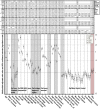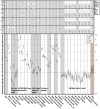Effects of particulate air pollution on cardiovascular health: a population health risk assessment
- PMID: 22432017
- PMCID: PMC3303831
- DOI: 10.1371/journal.pone.0033385
Effects of particulate air pollution on cardiovascular health: a population health risk assessment
Abstract
Particulate matter (PM) air pollution is increasingly recognized as an important and modifiable risk factor for adverse health outcomes including cardiovascular disease (CVD). However, there are still gaps regarding large population risk assessment. Results from the nationwide Behavioral Risk Factor Surveillance System (BRFSS) were used along with air quality monitoring measurements to implement a systematic evaluation of PM-related CVD risks at the national and regional scales. CVD status and individual-level risk factors were collected from more than 500,000 BRFSS respondents across 2,231 contiguous U.S. counties for 2007 and 2009. Chronic exposures to PM pollutants were estimated with spatial modeling from measurement data. CVD outcomes attributable to PM pollutants were assessed by mixed-effects logistic regression and latent class regression (LCR), with adjustment for multicausality. There were positive associations between CVD and PM after accounting for competing risk factors: the multivariable-adjusted odds for the multiplicity of CVD outcomes increased by 1.32 (95% confidence interval: 1.23-1.43) and 1.15 (1.07-1.22) times per 10 µg/m(3) increase in PM(2.5) and PM(10) respectively in the LCR analyses. After controlling for spatial confounding, there were moderate estimated effects of PM exposure on multiple cardiovascular manifestations. These results suggest that chronic exposures to ambient particulates are important environmental risk factors for cardiovascular morbidity.
Conflict of interest statement
Figures





Similar articles
-
Effects of long-term exposure to traffic-related air pollution on respiratory and cardiovascular mortality in the Netherlands: the NLCS-AIR study.Res Rep Health Eff Inst. 2009 Mar;(139):5-71; discussion 73-89. Res Rep Health Eff Inst. 2009. PMID: 19554969
-
Effect Modification of Long-Term Air Pollution Exposures and the Risk of Incident Cardiovascular Disease in US Women.J Am Heart Assoc. 2015 Nov 25;4(12):e002301. doi: 10.1161/JAHA.115.002301. J Am Heart Assoc. 2015. PMID: 26607712 Free PMC article.
-
PM2.5 air pollution and cause-specific cardiovascular disease mortality.Int J Epidemiol. 2020 Feb 1;49(1):25-35. doi: 10.1093/ije/dyz114. Int J Epidemiol. 2020. PMID: 31289812 Free PMC article.
-
Does utilizing WHO's interim targets further reduce the risk - meta-analysis on ambient particulate matter pollution and mortality of cardiovascular diseases?Environ Pollut. 2018 Nov;242(Pt B):1299-1307. doi: 10.1016/j.envpol.2018.07.041. Epub 2018 Jul 28. Environ Pollut. 2018. PMID: 30121484 Review.
-
Basic mechanisms for adverse cardiovascular events associated with air pollution.Heart. 2015 Feb;101(4):253-6. doi: 10.1136/heartjnl-2014-306379. Epub 2014 Dec 31. Heart. 2015. PMID: 25552258 Free PMC article. Review.
Cited by
-
Health Status and Quality of Life in the Population near Zhezkazgan Copper Smelter, Kazakhstan.J Environ Public Health. 2023 Jan 30;2023:8477964. doi: 10.1155/2023/8477964. eCollection 2023. J Environ Public Health. 2023. PMID: 36755778 Free PMC article.
-
An Approach to Improve the Performance of PM Forecasters.PLoS One. 2015 Sep 28;10(9):e0138507. doi: 10.1371/journal.pone.0138507. eCollection 2015. PLoS One. 2015. PMID: 26414182 Free PMC article.
-
Toxicity of antimony, copper, cobalt, manganese, titanium and zinc oxide nanoparticles for the alveolar and intestinal epithelial barrier cells in vitro.Cytotechnology. 2016 Dec;68(6):2363-2377. doi: 10.1007/s10616-016-0032-9. Epub 2016 Oct 19. Cytotechnology. 2016. PMID: 27761772 Free PMC article.
-
Cytotoxic, phytotoxic, and mutagenic appraisal to ascertain toxicological potential of particulate matter emitted from automobiles.Environ Sci Pollut Res Int. 2013 Jul;20(7):4817-30. doi: 10.1007/s11356-012-1431-x. Epub 2013 Jan 8. Environ Sci Pollut Res Int. 2013. PMID: 23296974
-
Role of H2O2 in the oxidative effects of zinc exposure in human airway epithelial cells.Redox Biol. 2014;3:47-55. doi: 10.1016/j.redox.2014.10.005. Epub 2014 Oct 31. Redox Biol. 2014. PMID: 25462065 Free PMC article.
References
-
- Cozzi E, Hazarika S, Stallings HW, 3rd, Cascio WE, Devlin RB, et al. Ultrafine particulate matter exposure augments ischemia-reperfusion injury in mice. Am J Physiol Heart Circ Physiol. 2006;291:H894–903. - PubMed
-
- Chen LC, Nadziejko C. Effects of subchronic exposures to concentrated ambient particles (CAPs) in mice. V. CAPs exacerbate aortic plaque development in hyperlipidemic mice. Inhal Toxicol. 2005;17:217–24. - PubMed
-
- Sun Q, Wang A, Jin X, Natanzon A, Duquaine D, et al. Long-term air pollution exposure and acceleration of atherosclerosis and vascular inflammation in an animal model. JAMA. 2005;294:3003–10. - PubMed
-
- Burnett RT, Dales R, Krewski D, Vincent R, Dann T, et al. Associations between ambient particulate sulfate and admissions to Ontario hospitals for cardiac and respiratory diseases. Am J Epidemiol. 1995;142:15–22. - PubMed
MeSH terms
Substances
LinkOut - more resources
Full Text Sources
Medical

